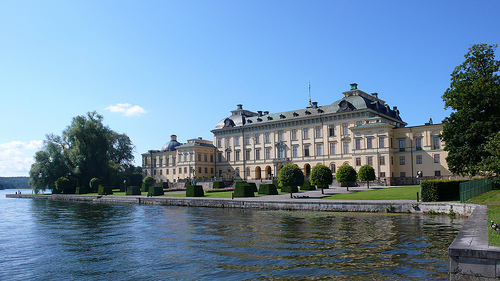

Location: Drottningholm Map
Constructed: started in the late 16th century
Tel. +(46) 8 402 6280
Drottningholm Palace is a royal residence constructed on the island Lovön in Drottningholm town in Sweden. Drottningholm Palace is on UNESCO World Heritage list due to its historical importance. Its construction started in the late 16th century under supervision of architect Nicodemus Tessin the Elder by commission of Queen Hedvig Eleonora. Behind Drottningholm Palace is the Court Theatre. It is one of the oldest theatres in the World. It was found in 1766 by the orders of Queen Lovisa Ulrika and constructed under supervision of court architect K.F. Adelkrants. Drottnigholm Palace is surrounded by a lush park decorated by beautiful pavilions and mazes in traditional English landscaping. In 1991 Drottningholm Palace along with surrounding complex was added to the list of UNESCO World Heritage Site.
The settlement has its origins in the village of
Glia, mentioned for the first time in document 1342. During the
siege of Stockholm in 1521, Gustav Vasa built a fortified camp at
Glia. to a royal farm, Glia farm . From 1559 the royal estate
instead goes by the name Torvesund.
Here Gustav Vasa's second son Johan III started erecting a castle
named Drottningholm in the beginning of 1579, according to his
queen. As an architect, the artist and architect Willem Boy was
hired . Shortly after the construction started, the plague broke out
in Stockholm and the construction was delayed. The Queen was
Catholic and Drottningholm came to play a special role as a refuge
for the last Catholics, who were persecuted in other parts of the
kingdom.
When Katarina Jagellonica died in 1583, the castle building was not
yet completed. Johan III stayed after his wife's death only on a few
occasions at Drottningholm, the last time being the summer of 1592.
The castle was owned from 1603 by Queen Katarina (Stenbock) and
after her death came several owners like the queens Kristina and
Maria Eleonora.
Around 1650 Magnus Gabriel De la Gardie took over Drottningholm, he
became interested in the building and its maintenance. He also began
a restoration work under the direction of architect Jean de la
Vallée .
When Hedvig Eleonora acquired the castle in 1661, it was a
two-storey stone house with a tower consisting of over 20 rooms in
the lower floor and about 10 rooms in the upper floor. In addition,
there was a chapel and a large hall with 36 windows.
1600s and 1700s
The 16th century castle burned down on December 30, 1661, the same
year that Hedvig Eleonora had bought it. After the devastating fire,
architect Nicodemus Tessin d.a. commissioned to erect a new castle
building based on the preserved walls and basement arches of Johan
III's castle. As early as the spring of 1662, a completed drawing
proposal was approved by the Queen. This plan over the plant
followed the modern construction of a castle called Entre cour et
jardin , which means that the castle faces a representative façade
against a courtyard in front of the castle and behind the castle a
garden spreads out.
While the main building was completed, Tessin continued. with the
design of the entire plant. Construction work progressed fairly
quickly because the workforce was large. In addition to the
professionals there were also specially arrived soldiers. In total,
there could be 400 people working at the same time with the castle
building.
In mid-1664 the main building was completed and the following year
the roof was laid. The building complex is about 160 meters long
(including the corner towers) and about 50 meters wide. The facade
color was not the same as today, but the walls were painted with red
paint, while the ceiling strip and the joinery were painted with
gray oil. Over the middle part of the castle was placed a tower
adorned with a crown, which is still visible on Wilhelm Swede's
copper engraving from 1692, however, the tower was taken down as
early as 1686. Today there is only a small copper-clad tower with
flagpole. Those of Tessin planned wing buildings to the east, on
both sides of the harbor were never executed, nor the balcony facing
the garden.
Until 1680, Tessin was d. Responsible architect. After his death,
the mission went to his son Nicodemus Tessin, then everything was
ready except the northern dome and adjoining lots. The interior work
had also begun. Drottningholm Castle became Tessin greatest work.